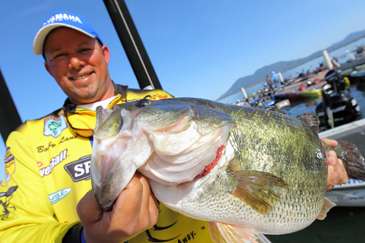
The tournament day was getting late, and Bobby Lane knew he needed 14 pounds, but he was one kicker fish away from making the final cut. “I had struggled all day,” Lane recalls of the tournament on Lake Okeechobee four years ago. “I came into an area right before weigh-in, and I needed to catch at least a 4- to 5-pound fish to make the cut. I gave myself about 30 minutes to fish the spot.
I was throwing a big number 6 willowleaf blade (spinnerbait) in there and caught a 6-pounder.” Whenever the water temperature looms in the low 50s to 60 degrees, Lane opts for a magnum-blade spinnerbait to catch heavyweight bass.
“A Rat-L-Trap is a great bait this time of year, and you’ll catch a lot of fish on it, but you’ll catch your bigger fish on a spinnerbait,” says the Elite Series competitor. “It’s a great time to throw big spinnerbaits, if you’re looking for that one big bite or for five bites a day.” The prespawn is Lane’s favorite time to tempt big bass with a spinnerbait worked slowly around any hydrilla, eelgrass, milfoil, peppergrass or lily pads he can find.
“Those big prespawn females know where they want to go to spawn, but they just won’t go up there yet because every third or fourth day a cold front approaches,” Lane says. “So they’ll hold back. Well, every couple of days that go by, those big females have to eat. So when something big and slow comes by, that gets their attention.” Slow is the key word for this presentation.
“The first thing you have to keep in mind in slow rolling a spinnerbait is the slower the better, but you also have to remember the blades do have to turn whether it’s a big willowleaf or a Colorado,” says Lane He throws a big Colorado in dirty water and willowleafs in clear water. “Those big blades get their attention and have great vibration.”
The 2011 Bassmaster Classic qualifier throws a spinnerbait with a number 5 or 6 gold Colorado blade in murky water, but switches to a silver willowleaf blade in the same sizes for clear water.
He opts for a 3/8-ounce model for slow rolling in the shallows and a 1/2-ounce version for slowly winding in water deeper than 5 feet. His magnum-blade spinnerbaits for dirty and clear water also include a smaller trailing Colorado blade.
Lane favors slow rolling Revenge and Humdinger spinnerbaits with white/chartreuse, chartreuse/blue or white/gold fleck skirts. If he’s fishing shallow wood or grass that tops out about 2 feet below the surface, Lane will start cranking his spinnerbait as soon as it hits the water.
When concentrating on brushpiles or other cover at depths of 8 to 10 feet, Lane lets his spinnerbait flutter down until it stops falling and then starts cranking just fast enough to feel the blade vibrating. He keeps his rod at the two o’clock position to help him feel the lure better and keep it off the bottom or out of the vegetation. “You don’t want to be dragging it in the mud, and you don’t want to be dragging it with a big mat of grass on it,” says Lane.
Using fluorocarbon line also helps Lane tell if his spinnerbait blade is thumping or bogged down in the grass. The Florida pro favors 15- to 25-pound Berkley Trilene 100 % Fluorocarbon line, which he throws on a 7-foot medium-heavy Abu-Garcia rod and an Abu-Garcia Revo SX 6.4:1 baitcast reel. Most strikes occur early or halfway through the presentation, but Lane recommends slow rolling a spinnerbait until it reaches the boat. “Sometimes those lethargic males or females will follow that thing all the way to the boat,” he says. A cloudy day is Lane’s favorite time to slow roll a spinnerbait for prespawn bass.
“I really enjoy it when a cold front comes through with some cloudy conditions,” he says. “The sun isn’t too bad, but it seems like in that situation they hunker down more to where the spinnerbait won’t get to them.”
Editor’s Note: If you have a story idea you would like to vote on for an upcoming poll, send your idea to john@jnoutdoors.com.





